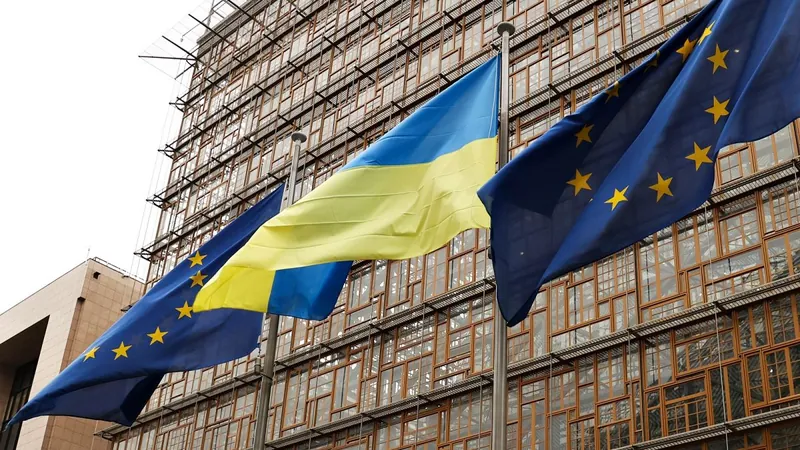
EU Approves €35 Billion Loan for Ukraine Using Frozen Russian Assets – A Game Changer Amid Ongoing Conflict!
2024-10-09
Author: Chun
EU Approves €35 Billion Loan for Ukraine
In a historic move, European Union countries have officially approved a groundbreaking plan to grant a €35 billion loan to Ukraine, using the frozen assets of the Russian Central Bank as collateral. This unprecedented financial assistance aims to bolster Ukraine's economy, severely affected by the ongoing war with Russia.
Financial Support from G7 Allies
This initiative aligns with a broader commitment by G7 allies, who are expected to provide a total of €45 billion ($50 billion) to Ukraine imminently. The nation is currently grappling with intensified Russian attacks, which have inflicted extensive damage on its infrastructure and strained its military resources.
Undesignated and Untargeted Loan
Notably, the €35 billion loan will be categorized as "undesignated" and "untargeted," empowering the Ukrainian government with the flexibility to allocate funds wherever they are most needed. European officials anticipate that the disbursement of these funds will commence early next year.
Hungary's Role in the Agreement
The agreement was finalized on Wednesday by EU ambassadors, following a contentious announcement by Hungary stating it would delay a crucial amendment to the EU sanctions framework until after the United States presidential elections on November 5. This amendment is aimed at extending the renewal period for the sanctions on frozen Russian assets from the current six months to 36 months, thereby providing greater stability to the arrangement. Hungary’s finance minister, Mihály Varga, voiced concerns about discussing sanctions until after the U.S. elections.
Aiming for Stability in Sanctions
The longer renewal period seeks to eliminate uncertainties and mitigate the risks posed by any one EU member state potentially blocking the sanctions, thereby jeopardizing the entire initiative. Hungary has been viewed as a risk factor due to its historical reluctance to endorse sanctions against Russia, often conditioned on obtaining favorable concessions.
Repayment from Frozen Assets
Under the G7 framework, any profits accrued from the frozen assets will be instrumental in systematically repaying the loans extended to Ukraine. If these profits fail to materialize, the burden will ultimately revert to Western nations to shoulder the financial responsibilities.
Changes in Funding Commitments
Initially, both the EU and the U.S. were expected to contribute €18 billion ($20 billion) each towards the loan. However, ambiguity regarding U.S. pledges prompted the EU to significantly increase its commitment to €35 billion. The EU's financial contribution might be scaled back should the U.S., Canada, the UK, Japan, and potentially Australia enhance their financial support.
Pending Ratification by European Parliament
Despite the progress made, the plan will ultimately require ratification by the European Parliament, signaling a cautious optimism about financial mobilization before year-end and possible fund distribution beginning in early 2025. Yet, Hungary's hesitance over the sanctions amendments could complicate advancements at the G7 level, where the U.S. is also expected to increase its funding contingent on ratified sanctions.
Impact on Ukraine's Economic Landscape
As the conflict in Ukraine rages on, this significant financial maneuver promises to reshape the economic landscape for Ukraine while offering a new strategy for Western nations to leverage frozen Russian assets in their bid to support Kyiv in facing ongoing aggressions. Will this loan be the lifeline Ukraine needs? Stay tuned as events unfold in this critical geopolitical saga!





 Brasil (PT)
Brasil (PT)
 Canada (EN)
Canada (EN)
 Chile (ES)
Chile (ES)
 España (ES)
España (ES)
 France (FR)
France (FR)
 Hong Kong (EN)
Hong Kong (EN)
 Italia (IT)
Italia (IT)
 日本 (JA)
日本 (JA)
 Magyarország (HU)
Magyarország (HU)
 Norge (NO)
Norge (NO)
 Polska (PL)
Polska (PL)
 Schweiz (DE)
Schweiz (DE)
 Singapore (EN)
Singapore (EN)
 Sverige (SV)
Sverige (SV)
 Suomi (FI)
Suomi (FI)
 Türkiye (TR)
Türkiye (TR)